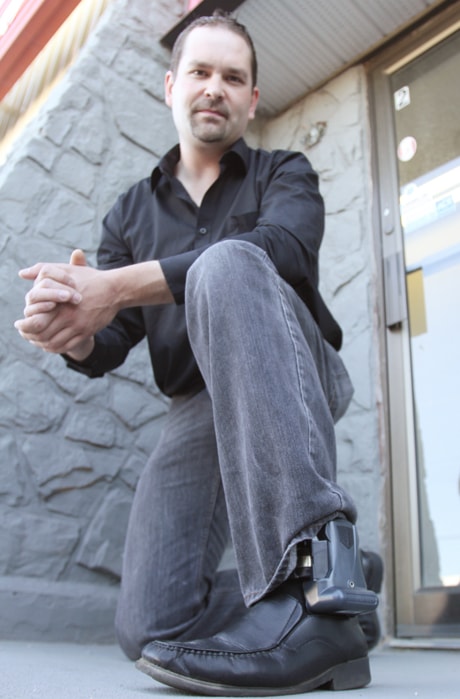A convicted pedophile on conditional release approaches a youngster at a playground. But before he can reach the child, a device strapped to his ankle emits an ear-piercing alarm, followed by the stern voice of a police officer.
The man flees, but is located and apprehended within minutes.
Thanks to electronic GPS monitoring, such preventive policing is not only possible but is currently used by law enforcement agencies, including in Alberta. And helping supply the technology is a Red Deer company called SafeTracks GPS Solutions Inc.
SafeTracks provides GPS-equipped ankle bracelets that can be worn by people like high-risk offenders and perpetrators of domestic violence. Weighing just 16 ounces, the units can be set to vibrate if they enter a pre-established restricted area, and/or emit a 95-decible alarm. They also contain a cellphone, allowing for two-way communication between authorities and the person being monitored.
They can be worn in a shower, and alert monitoring officials if their battery is not being recharged or their reinforced cuff is being tampered with.
“I took four-foot bolt cutters and tried to cut this off, and I couldn’t,” said SafeTracks president and founder Vince Morelli.
The origins of SafeTracks date back several years, when Morelli began pondering ways to protect victims of domestic violence. He teamed up with Bob Aloisio, the company’s director of business development, who had an extensive background in global positioning systems, telematics and automated vehicle location technologies.
The two men began testing GPS tracking systems.
“We had probably 15 different devices in here,” said Morelli, adding that the units were carefully scrutinized, and even frozen, as part of the evaluation process.
“We did everything to them.”
Ultimately, a unit produced by a Salt Lake City, Utah, company emerged as the clear choice. Morelli and Aloisio then did an extensive review of the available software, and after making their selection redeveloped it for use in Canada.
Finally, they entrusted the entire system to Northern911 Emergency Response Centre of Sudbury, Ont. — one of the largest independent monitoring centres in North America.
“The No. 1priority was to make sure everything stayed in Canada,” said Morelli, stressing the importance of having equipment and software suitable for the conditions here, and also of ensuring that the monitoring data remains in this country.
SafeTracks is now promoting its system to law enforcement agencies and other organizations across Canada.
“We’ve got stuff going down east that we’re going to be working with, we’ve got stuff in this province,” said Morelli.
Clients include the Edmonton Police Service, which uses electronic monitoring in situations involving high-risk offenders and domestic violence.
“We use it as a tool to encourage compliance with conditions,” said James Clover, a detective with the Edmonton Police Service’s behavioural assessment unit.
Those conditions include such things as adhering to curfews, attending work or programming, and staying away from parks and playgrounds.
The technology is not a replacement for jail, stressed Clover, but helps police ensure that offenders comply with the conditions of their release.
“It’s shown its merit for those very specific cases where we needed that extra tool to encourage compliance and to have an ability to keep an offender compliant.”
Electronic monitoring helps law enforcement agencies make more efficient use of their resources, suggested Clover. For example, it can eliminate the need for officers to attend at an offender’s home to ensure he’s complying with a curfew order.
“That keeps two policemen on the road to do what we want them to do, and yet we know that the offender is being accountable.”
Clover emphasized that the Edmonton Police Service does not endorse any company or specific products when it comes to electronic monitoring.
Morelli and Aloisio described the versatility of GPS monitoring. An offender wearing a SafeTracks ankle bracelet might be required to remain outside an exclusion zone, like a school yard or a former spouse’s home; or inside an inclusion zone, such as his home or workplace.
Precise zones can be programmed for each unit, and a specific set of “protocols” established for the monitoring centre to follow in the event of a breach — for instance, a vibrating warning, verbal commands via the cellphone, activation of the siren, and finally notification of designated law enforcement agents.
Zones can be shaped to any configuration, said Morelli. They might encompass an offender’s house and the route to his mailbox, or his workplace and the specific route he must follow to get there.
Adherence to a daily schedule, such as a curfew, can also be enforced.
The monitoring centre can continuously track the wearer’s location, direction of travel and speed, and determine where he’s been and when.
Morelli and Aloisio see tremendous potential for their system, which can be used to monitor people released on bail or awaiting sentencing, parolees, and offenders under preventive recognizances, among others.
“Can you imagine in 10 years where this is going to be?” asked Morelli. “It’s unlimited.”
hrichards@www.reddeeradvocate.com
